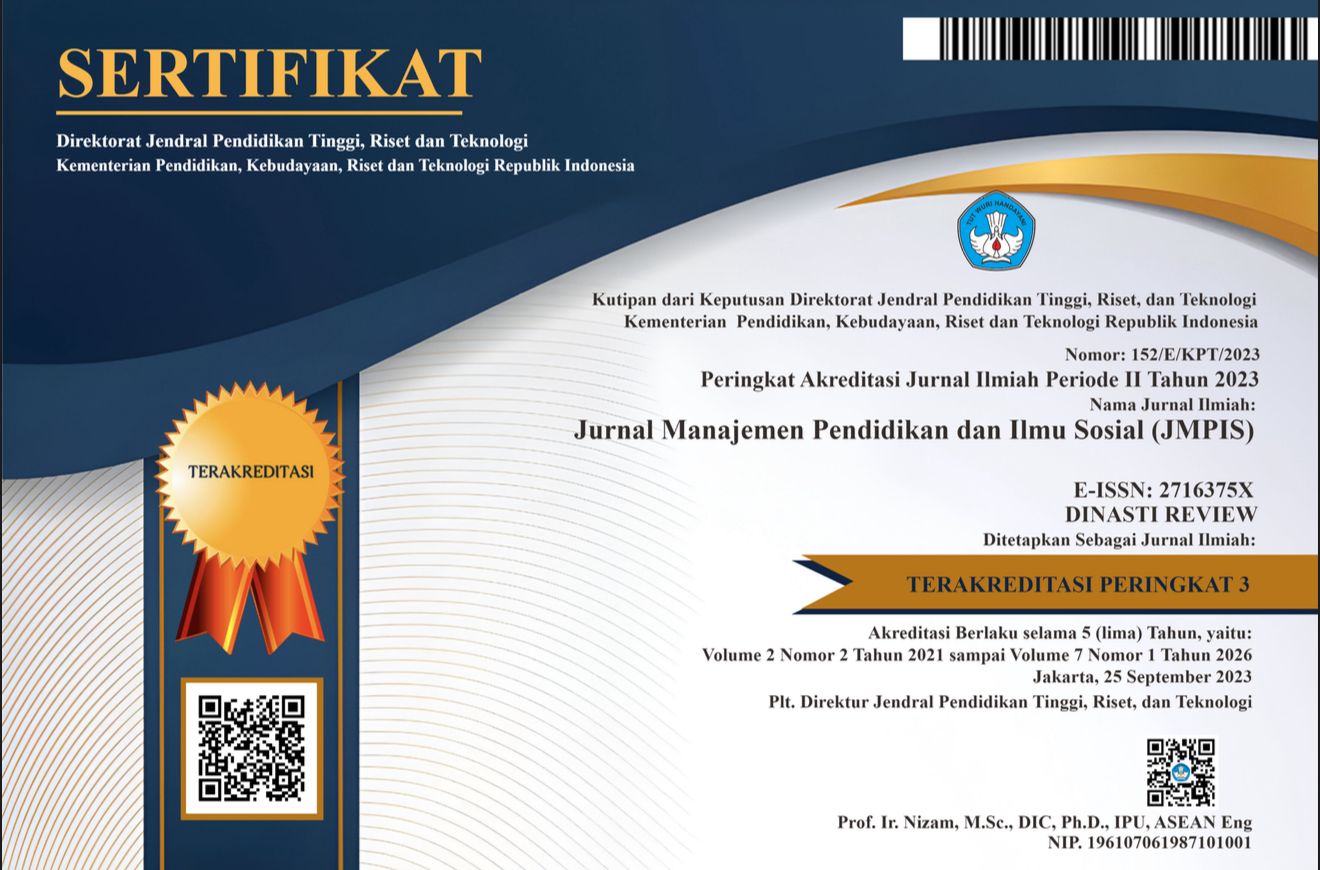Pengaruh Attitude dan Enjoyment Terhadap Learning Outcome pada Pelatihan Keselamatan dan Kesehatan Kerja Berbasis E-Learning di Perusahaan Manufaktur
DOI:
https://doi.org/10.38035/jmpis.v6i4.4864Keywords:
Keselamatan dan Kesehatan Kerja (K3), E-Learning, Sikap, Niat menggunakan, Perubahan perilakuAbstract
Pelatihan Keselamatan dan Kesehatan Kerja (K3) memiliki peran penting dalam mencegah kecelakaan dan melindungi keselamatan pekerja di berbagai sektor, termasuk industri manufaktur. Seiring dengan meningkatnya kebutuhan akan pelatihan K3, terutama setelah pandemi COVID-19, pelatihan berbasis e-learning semakin diterapkan untuk memberikan fleksibilitas dan efisiensi. Namun, efektivitas pelatihan K3 berbasis e-learning di lingkungan manufaktur masih belum banyak diteliti. Penelitian ini bertujuan untuk menganalisis pengaruh attitude toward online education dan enjoyment terhadap learning outcome pada pelatihan Keselamatan dan Kesehatan Kerja (K3) berbasis e-learning di perusahaan manufaktur. Dengan menggunakan pendekatan quantitative confirmatory, penelitian dilakukan pada 358 responden yang terdiri dari operator, foreman, dan section head di salah satu perusahaan manufaktur di Jakarta. Analisis data menggunakan Covariance-Based Structural Equation Modeling (CB-SEM) menunjukkan bahwa attitude toward online education berpengaruh positif dan signifikan terhadap enjoyment, enjoyment berpengaruh positif dan signifikan terhadap intention to use, dan intention to use berpengaruh positif dan signifikan terhadap behavioral change. Namun, attitude toward online education tidak memiliki pengaruh langsung yang signifikan terhadap intention to use. Temuan penelitian ini memberikan implikasi penting bagi perusahaan manufaktur dalam pengembangan strategi pelatihan K3 berbasis e-learning yang efektif, dengan menekankan pentingnya menciptakan pengalaman belajar yang menyenangkan untuk meningkatkan intention to use dan behavioral change terkait keselamatan kerja.
References
Ajzen, I., & Fishbein, M. (1975). Belief, attitude, attitude, intention and behavior: An introduction to theory of research. Reading, MA?: Addison-Wesley.
Babalola, A., Manu, P., Cheung, C., Yunusa-Kaltungo, A., & Bartolo, P. (2023). Applications of immersive technologies for occupational safety and health training and education: A systematic review. In Safety Science (Vol. 166). Elsevier B.V. https://doi.org/10.1016/j.ssci.2023.106214
Bhatt, P., & Muduli, A. (2024). AI learning intention, learning engagement and behavioral outcomes: an empirical study. Journal of Management Development. https://doi.org/10.1108/JMD-05-2024-0173
Chao, C. M. (2019). Factors determining the behavioral intention to use mobile learning: An application and extension of the UTAUT model. Frontiers in Psychology, 10(JULY). https://doi.org/10.3389/fpsyg.2019.01652
Fan, J., & Zhang, Q. (2024). From literacy to learning: The sequential mediation of attitudes and enjoyment in AI-assisted EFL education. Heliyon, 10(17). https://doi.org/10.1016/j.heliyon.2024.e37158
Gajendragadkar, S., Arora, R., Trivedi, R., & Neelam, N. (2024). From intentions to action: how behavioural intentions shape employee performance through digital learning? Journal of Workplace Learning, 36(5), 348–363. https://doi.org/10.1108/JWL-02-2024-0021
Hair, J., Black, W., Babin, B., & Anderson, R. (2010). Multivariate Data Analysis: A Global Perspective. In Multivariate Data Analysis: A Global Perspective (Vol. 7th).
Hair Jr., J. F., Anderson, R. E., Babin, B. J., & Black, W. C. (2019). Multivariate Data Analysis, Multivariate Data Analysis. In Book (Vol. 87, Issue 4).
Hamari, J., Shernoff, D. J., Rowe, E., Coller, B., Asbell-Clarke, J., & Edwards, T. (2016). Challenging games help students learn: An empirical study on engagement, flow and immersion in game-based learning. Computers in Human Behavior, 54. https://doi.org/10.1016/j.chb.2015.07.045
Hu, X., Zhang, J., He, S., Zhu, R., Shen, S., & Liu, B. (2022). E-learning intention of students with anxiety: Evidence from the first wave of COVID-19 pandemic in China. Journal of Affective Disorders, 309, 115–122. https://doi.org/10.1016/j.jad.2022.04.121
Kementerian Ketenagakerjaan Republik Indonesia. (2022). Profil Keselamatan dan Kesehatan Kerja Nasional Indonesia Tahun 2022.
Kim, B. J., & Chung, J. B. (2023a). Is safety education in the E-learning environment effective? Factors affecting the learning outcomes of online laboratory safety education. Safety Science, 168. https://doi.org/10.1016/j.ssci.2023.106306
Kim, B. J., & Chung, J. B. (2023b). Is safety education in the E-learning environment effective? Factors affecting the learning outcomes of online laboratory safety education. Safety Science, 168. https://doi.org/10.1016/j.ssci.2023.106306
Kirkpatrick, D. L., & Kirkpatrick, J. D. (2009). Evaluating Training Programs, The Four Levels.Third Edition. In USA: Berrett-Koehler Publishers.
Lee, M. C. (2010a). Explaining and predicting users’ continuance intention toward e-learning: An extension of the expectation-confirmation model. Computers and Education, 54(2). https://doi.org/10.1016/j.compedu.2009.09.002
Lee, M. C. (2010b). Explaining and predicting users’ continuance intention toward e-learning: An extension of the expectation-confirmation model. Computers and Education, 54(2). https://doi.org/10.1016/j.compedu.2009.09.002
Lin, W. S., & Wang, C. H. (2012). Antecedences to continued intentions of adopting e-learning system in blended learning instruction: A contingency framework based on models of information system success and task-technology fit. Computers and Education, 58(1). https://doi.org/10.1016/j.compedu.2011.07.008
Liu, G. L., Zhao, X., & Yang, B. (2024). The predictive effects of motivation, enjoyment, and self-efficacy on informal digital learning of LOTE: Evidence from French and German learners in China. System, 126. https://doi.org/10.1016/j.system.2024.103504
Loosemore, M., & Malouf, N. (2019). Safety training and positive safety attitude formation in the Australian construction industry. Safety Science, 113, 233–243. https://doi.org/10.1016/J.SSCI.2018.11.029
Man, S. S., Wen, H., & So, B. C. L. (2023). Are virtual reality applications effective for construction safety training and education? A systematic review and meta-analysis. Journal of Safety Research. https://doi.org/10.1016/j.jsr.2023.11.011
Min, S. N., Kim, S., & Kang, C. (2023). Efficient safety management plan for industrial accident prevention of hazardous machinery: Focus on safety certification system and regulations in South Korea. Safety Science, 165. https://doi.org/10.1016/j.ssci.2023.106201
Nagy, J. T. (2018). Evaluation of online video usage and learning satisfaction: An extension of the technology acceptance model. International Review of Research in Open and Distributed Learning, 19(1). https://doi.org/10.19173/irrodl.v19i1.2886
Rahouti, A., Lovreglio, R., Datoussaïd, S., & Descamps, T. (2021). Prototyping and Validating a Non-immersive Virtual Reality Serious Game for Healthcare Fire Safety Training. Fire Technology, 57(6). https://doi.org/10.1007/s10694-021-01098-x
Rey-Becerra, E., Barrero, L. H., Ellegast, R., & Kluge, A. (2021a). The effectiveness of virtual safety training in work at heights: A literature review. In Applied Ergonomics (Vol. 94). https://doi.org/10.1016/j.apergo.2021.103419
Rey-Becerra, E., Barrero, L. H., Ellegast, R., & Kluge, A. (2021b). The effectiveness of virtual safety training in work at heights: A literature review. In Applied Ergonomics (Vol. 94). https://doi.org/10.1016/j.apergo.2021.103419
San Jose, A. (2021). Translating Theory into Practice: The Gender and Development Training Evaluations using the Kirkpatrick’s Model. SSRN Electronic Journal. https://doi.org/10.2139/ssrn.3908296
Stefan, H., Mortimer, M., Horan, B., & Kenny, G. (2023). Evaluating the preliminary effectiveness of industrial virtual reality safety training for ozone generator isolation procedure. Safety Science, 163. https://doi.org/10.1016/j.ssci.2023.106125
Su, C. Y., & Chiu, C. H. (2021). Perceived Enjoyment and Attractiveness Influence Taiwanese Elementary School Students’ Intention to Use Interactive Video Learning. International Journal of Human-Computer Interaction, 37(6), 574–583. https://doi.org/10.1080/10447318.2020.1841423
Teo, T., & Noyes, J. (2011). An assessment of the influence of perceived enjoyment and attitude on the intention to use technology among pre-service teachers: A structural equation modeling approach. Computers and Education, 57(2), 1645–1653. https://doi.org/10.1016/j.compedu.2011.03.002
Yusuf, M. (2011). The impact of self-efficacy, achievement motivation, and self-regulated learning strategies on students’ academic achievement. Procedia - Social and Behavioral Sciences, 15. https://doi.org/10.1016/j.sbspro.2011.04.158
Downloads
Published
How to Cite
Issue
Section
License
Copyright (c) 2025 Richard Rizaldi, Elok Savitri Pusparini

This work is licensed under a Creative Commons Attribution 4.0 International License.
Hak cipta :
Penulis yang mempublikasikan manuskripnya di jurnal ini menyetujui ketentuan berikut:
- Hak cipta pada setiap artikel adalah milik penulis.
- Penulis mengakui bahwa Jurnal Manajemen Pendidikan dan Ilmu Sosial (JMPIS) berhak menjadi yang pertama menerbitkan dengan lisensi Creative Commons Attribution 4.0 International (Attribution 4.0 International CC BY 4.0) .
- Penulis dapat mengirimkan artikel secara terpisah, mengatur distribusi non-eksklusif manuskrip yang telah diterbitkan dalam jurnal ini ke versi lain (misalnya, dikirim ke repositori institusi penulis, publikasi ke dalam buku, dll.), dengan mengakui bahwa manuskrip telah diterbitkan pertama kali di Jurnal Manajemen Pendidikan dan Ilmu Sosial (JMPIS).











































































